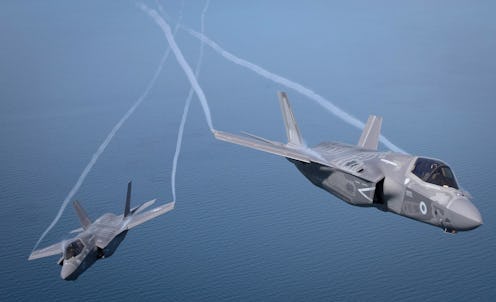News
Trump Actually Said That The U.S. Has Invisible Planes (And It's Not The First Time)

At a press conference Thursday, President Trump implied that the United States has invisible planes, the third time in less than six months that he's made such a suggestion. Trump made the comments at an event with Lockheed Martin CEO Marillyn Hewson, to whom Trump incorrectly referred as "Marillyn Lockheed" moments before touting America's invisible planes, which do not exist.
"I may ask Marillyn Lockheed, the leading woman's business executive in this country, according to many," Trump said, mixing up the CEO's last name with the name of the company she leads. "We buy billions and billions of dollars worth of that beautiful F-35. It's stealth. You cannot see it. Is that correct?"
"That's correct, Mr. —," Hewson began.
"Better be correct, right?" Trump interrupted. "Marillyn, please say a few words."
With some very limited exceptions, it's not currently possible to render physical objects invisible. However, Thursday was at least the third time Trump has implied that America has planes that can't be seen with the naked eye.
At a military briefing in Puerto Rico in October, Trump said that "you literally can't see" the F-35, then quipped that "it's hard to fight a plane you can't see." He repeated this claim on Thanksgiving, telling the Coast Guard that he spoke to "some Air Force guys" about an "invisible" plane that the military possesses.
“They said, ‘Well, it wins every time because the enemy cannot see it, even if it’s right next to it, it can’t see it,’” Trump insisted.
Trump appears to be mixing up literal invisibility with stealth technology, an umbrella term that refers to a wide variety of camouflage measures used by military vehicles. As noted by Josh Billinson of the Independent Journal-Review, Lockheed Martin's website specifically addresses this confusion.
Twitter roundly mocked the president for his past claims about invisible jets, and it was no different this most recent time.
Although invisible planes don't exist, Chinese media reported in 2013 that a team of scientists had constructed a material that could render objects invisible to the eye under certain limited circumstances. But those scientists didn't claim to have applied the technology to aircraft, and a computing science professor at Villanova University insisted at the time that the entire thing was a hoax.
"There is absolutely no way given our current understanding of physics that something could be made invisible to the naked eye," Thomas Way told Fox News. "If that's what they are claiming, it's a hoax."
The primary focus of the Thursday event was not planes, however, but tariffs. Trump announced that he is imposing $60 billion in tariffs on China in retaliation for what he called "a tremendous intellectual property theft problem" on behalf of Chinese manufacturers. It was the second round of tariffs Trump has announced the last month after imposing 10 and 25 percent tariffs on aluminum and steel, respectively, earlier in March.
"We have spoken to China and we are in the midst of a very large negotiation," Trump said on Thursday. "We will see where it takes us."
Trump's tariffs on China quickly sparked fears of a global trade war, which in turn caused the Dow Jones to plummet 724 points on Thursday — the fifth-largest decline in the index's history. China's ambassador to the United States responded that Chinese leaders are ready for a trade war if necessary.
“We don’t want a trade war,” Cui Tiankai wrote on Facebook. “But we are not afraid of it...we will certainly fight back and retaliate. If people want to play tough, we will play tough with them and see who will last longer.”